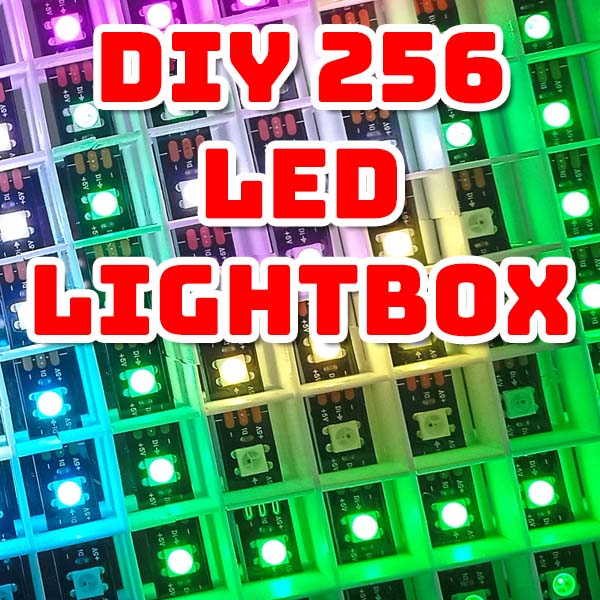
Make and Code Your Own 256 Full Colour LED Lightbox – DIY Project
13th August 2023
Raspberry Pi 5 Launched
28th September 2023How To Build Your 256 Full Colour LED Lightbox – DIY Project
In my last video I gave you an overview of my 256 pixel, RGB LED lightbox project.
In this video I’ll show you how to make it.
Design and Code Files
For all the design and code files please go to
https://github.com/getis/pi-pico-rgb-led-lightbox
You’ll find the parts lists, 3d Print files and circuit diagrams.
Build Instructions
Please refer to the video for full details, but I’ll also run through the main process here.
- There are a lot of 3D printed parts required for the framework. If you don’t have access to a 3D printer you can make the led cell dividers from thick cardboard. The framework can be built from strips of MDF. There should be enough room at the edges of the perspex sheets for you to mount a strip between the back mirror and the front diffuser.
- For the 3D parts you need to glue the frame side pieces to the base corner pieces. The side pieces are all the same. The top and bottom pieces come in two variations for left and right. You should leave the top frame pieces unglued so you can remove these for maintenance. Please see the video.
- Drill an exit hole for the wiring in one of the assembled corner pieces.
- The perspex sheets should be 300mm x 300mm and 3mm thick.
- The LEDs need to be the 60 pixels per metre variety.
- To construct the framework you need to assemble all the parts; glued corner pieces, rear mirror panel and front diffuser. Lay this on the MDF sheet and mark the position. Then run a glue bead around the marked position and glue the 3D printed corner assemblies into place. This should leave you with a framework to hold the mirros and diffuser in place.
- Mark out the mirror sheet as shown in the video and stick the LED strips into place. Be very careful to place the LED strips in the correct direction. Data flows in one way along the strips and has to follow a zig-zag pattern up the full 16 strip array. Again check the video.
- Wire up the LED strips with power and data lines as shown in the video.
- Piece together the divider strips and trim the ends to create a 16×16 cell grid that will fit inside the framework.
- Glue the mirror/led array into place.
- Glue the divider grid into place.
- Slide the diffuser into place and place the top framework pieces in place.
- The circuit can be built in whatever way you desire. I’ve used matrix board at this stage but will be moving to a PCB design in a following project.
This should give you a fully assembled lightbox.
Software
Copy all the GitHub repository files onto your Micropython enables Raspberry Pico.
The circuit_test.py file will test the full LED matrix, buttons and on circuit LEDs. You’ll need to run this through the REPL terminal. The test code will print button presses through this terminal.
Parts List
Raspberry Pi Pico 16×16 RGB LED Lightbox Circuit Parts
1 off Max 9814 Microphone Unit – https://amzn.to/3PrsPFw
1 off Pack of PCB Terminals – 1 pack off https://amzn.to/3sHTeGg
1 off Pack of PCB Header Connectors – 1 pack off https://amzn.to/44Gj1Mm
1 off PCB Mount DC Power Connector Female – 1 pack off https://amzn.to/44zBRok
6 off PCB Push Button Switches – 1 pack off https://amzn.to/47ZB9Ue
1 off 5m Reel WS2812 Neopixels, 60 pixels/m – https://amzn.to/3sIgMuN
1 off Raspberry Pi Pico W with Headers – https://amzn.to/3sIh057
1 off 5V 10A PSU – https://amzn.to/44EgkL1
Sheet Material
1 off Opal Frosted Acrylic Sheet – 3mm thick x 300mm wide x 300mm height
1 off Mirror Acrylic Sheet – 3mm thick x 300mm wide x 300mm height
1 off Standard MDF Sheet – 6mm thick x 300mm wide x 415mm height
3D Printed Parts
filenames refer to files in the /parts/stl folder
34 off horz_divider.stl
34 off vert_divider.stl
4 off frame-bottom.stl
4 off frame-top-side.stl
2 off frame-top-top-left.stl
2 off frame-top-top-right.stl
**IMPORTANT**
Amazon will sometimes find the wrong product in your country. The LEDs need to be 5V, WS2812 LED strips at 60 pixels per metre (300 per 16.4 feet).




